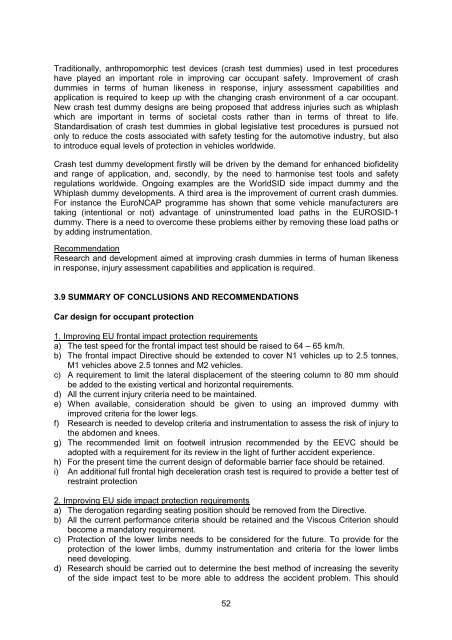PRIORITIES FOR EU MOTOR VEHICLE SAFETY DESIGN
priorities for eu motor vehicle safety design - ETSC
priorities for eu motor vehicle safety design - ETSC
Create successful ePaper yourself
Turn your PDF publications into a flip-book with our unique Google optimized e-Paper software.
Traditionally, anthropomorphic test devices (crash test dummies) used in test procedures<br />
have played an important role in improving car occupant safety. Improvement of crash<br />
dummies in terms of human likeness in response, injury assessment capabilities and<br />
application is required to keep up with the changing crash environment of a car occupant.<br />
New crash test dummy designs are being proposed that address injuries such as whiplash<br />
which are important in terms of societal costs rather than in terms of threat to life.<br />
Standardisation of crash test dummies in global legislative test procedures is pursued not<br />
only to reduce the costs associated with safety testing for the automotive industry, but also<br />
to introduce equal levels of protection in vehicles worldwide.<br />
Crash test dummy development firstly will be driven by the demand for enhanced biofidelity<br />
and range of application, and, secondly, by the need to harmonise test tools and safety<br />
regulations worldwide. Ongoing examples are the WorldSID side impact dummy and the<br />
Whiplash dummy developments. A third area is the improvement of current crash dummies.<br />
For instance the EuroNCAP programme has shown that some vehicle manufacturers are<br />
taking (intentional or not) advantage of uninstrumented load paths in the <strong>EU</strong>ROSID-1<br />
dummy. There is a need to overcome these problems either by removing these load paths or<br />
by adding instrumentation.<br />
Recommendation<br />
Research and development aimed at improving crash dummies in terms of human likeness<br />
in response, injury assessment capabilities and application is required.<br />
3.9 SUMMARY OF CONCLUSIONS AND RECOMMENDATIONS<br />
Car design for occupant protection<br />
1. Improving <strong>EU</strong> frontal impact protection requirements<br />
a) The test speed for the frontal impact test should be raised to 64 – 65 km/h.<br />
b) The frontal impact Directive should be extended to cover N1 vehicles up to 2.5 tonnes,<br />
M1 vehicles above 2.5 tonnes and M2 vehicles.<br />
c) A requirement to limit the lateral displacement of the steering column to 80 mm should<br />
be added to the existing vertical and horizontal requirements.<br />
d) All the current injury criteria need to be maintained.<br />
e) When available, consideration should be given to using an improved dummy with<br />
improved criteria for the lower legs.<br />
f) Research is needed to develop criteria and instrumentation to assess the risk of injury to<br />
the abdomen and knees.<br />
g) The recommended limit on footwell intrusion recommended by the EEVC should be<br />
adopted with a requirement for its review in the light of further accident experience.<br />
h) For the present time the current design of deformable barrier face should be retained.<br />
i) An additional full frontal high deceleration crash test is required to provide a better test of<br />
restraint protection<br />
2. Improving <strong>EU</strong> side impact protection requirements<br />
a) The derogation regarding seating position should be removed from the Directive.<br />
b) All the current performance criteria should be retained and the Viscous Criterion should<br />
become a mandatory requirement.<br />
c) Protection of the lower limbs needs to be considered for the future. To provide for the<br />
protection of the lower limbs, dummy instrumentation and criteria for the lower limbs<br />
need developing.<br />
d) Research should be carried out to determine the best method of increasing the severity<br />
of the side impact test to be more able to address the accident problem. This should<br />
52



